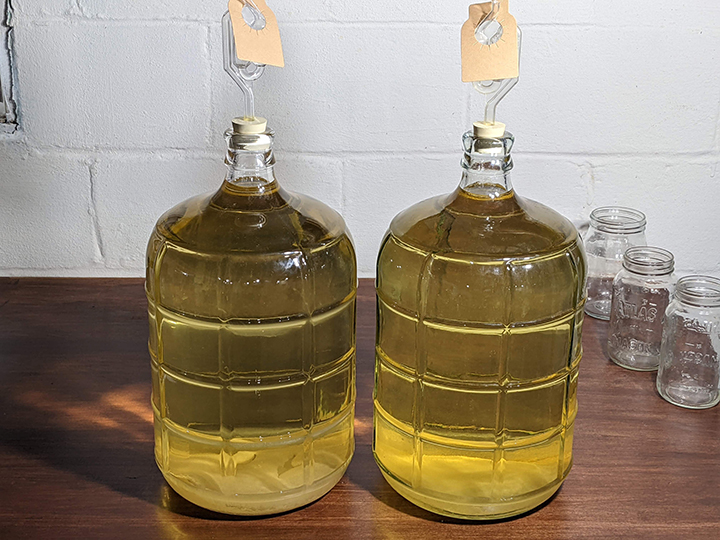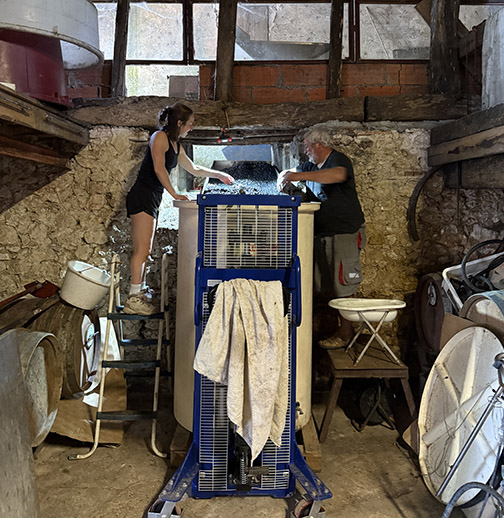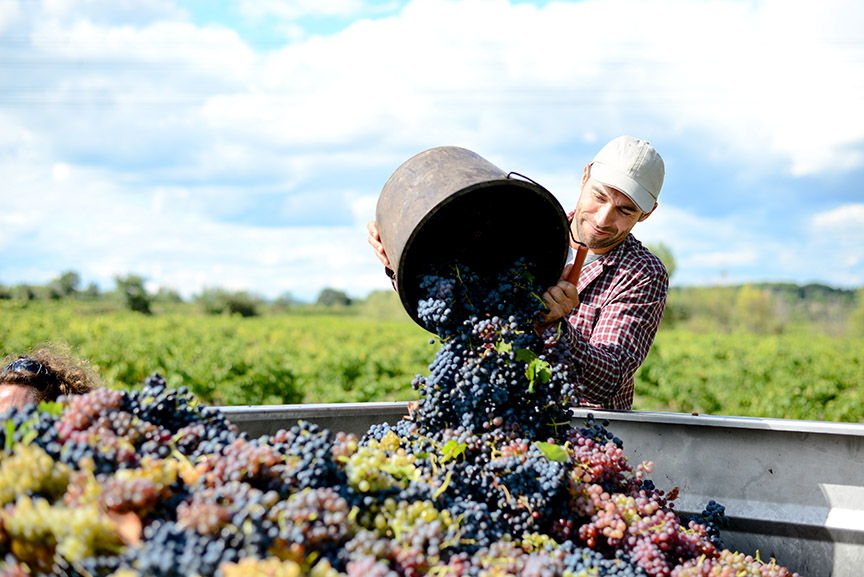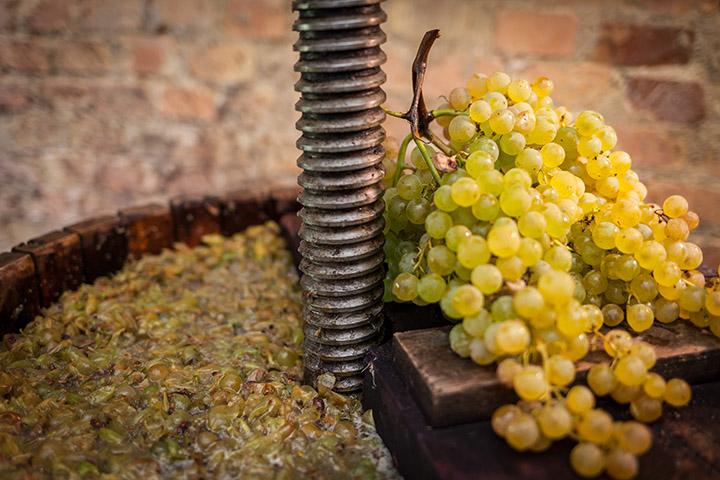When Grapes Throw You for a Curve
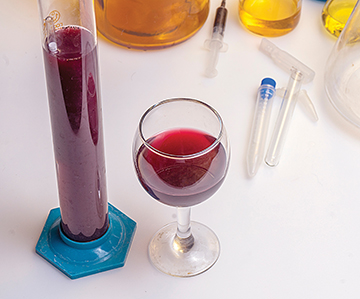
By now harvest is right around the corner or you are perhaps already into your winemaking efforts. This comes after several months of planning and anxieties of how this year’s vintage will turn out. But, as anyone who has been making wine over several vintages knows, the grapes you obtain for winemaking may not be what you had hoped for.
Winemakers that obtain their grapes from a grower are dependent on what the grower provides and the considerations of harvest timing, grape quality and/or condition. Even if you grow your own grapes like us, the unexpected still happens in the vineyard that is beyond your control but will play a big role in what you do during the winemaking process. Just remember that the unexpected will likely happen and you may have to change your game plan once grapes arrive and the winemaking process begins. Anticipating these unexpected events is the epitome of planning.
We’ve rarely had a growing year, harvest, or vintage that did not have some unexpected condition come up to require a modification to our planning. In our very first vintage where we sourced grapes from a local grower we made arrangements to pick up the grapes the day they were being picked. Upon our arrival to the vineyard the grower completely forgot our order and also noted that the variety we requested was picked the previous day. We were fortunate that something else was being picked the day we showed up. We still made a very successful wine that year.
We had one year in which the Barbera we were processing had extremely bright and clear juice with a small touch of color coming out of the crusher/destemmer. It was unexpected, but we immediately changed our game plan and took part of that juice/must straight to the press and made preparations for fermentation of a vin gris-style rosé. The resulting rosé was delicious, but always mistakenly judged as oxidized due to its deep salmon color.
The last couple of vintages experienced rains in the last month preceding harvest. Temperature levels between several rains made the condition for bunch rot optimum, so cluster damage was severe and widespread. The later ripening varieties were more affected, as they needed more time on the vine to ripen and reach their Brix/pH objectives. We ultimately made an on the fly decision in the vineyard to pick a higher quantity of grapes earlier at a lower Brix level for our rosé production, thus minimizing the bunch rot condition.
Our 2021 harvest experienced a catastrophic wildfire (the Caldor Fire) that required us to evacuate our home and property where the vineyard also sits. We had smoke in the immediate area of the vineyard for several days, but it was not severe due to winds predominantly blowing away from us. Our concerns of smoke damage were reduced based on information that had come out of UC-Davis about smoke taint so we did not do any remediation to change any previous harvest and production planning. The 2021 wines, some currently in barrel and some in bottle, do not show any evidence of smoke taint and are expected to be a wonderful vintage. That said, we still came up with a plan in case we had to change course.
Even at the writing of this article in mid-April of 2022 we find ourselves in the midst of a hard freeze with sustained temperatures of 27 °F (-3 °C) in the vineyard for more than five hours. We did a late pruning the first week of April to minimize early bud break but new growth was already evident. Crop yields will obviously be affected, so we already know that adjustments to wine production will need to be made even before we get fruit harvested. Such is the nature for us winemakers.
Planning for Success
This article provides options to help you pivot with your winemaking decisions at the crush pad to mitigate issues with the grapes that you have received. Some important points start with the planning process well before your grapes arrive. Proper planning will give a sense of relief that you are ready for the worst case and positioned to change your game plan once the winemaking process starts.
The most obvious factor for success is identifying your source of grapes, must, or juice well ahead of harvest. If your sourcing efforts start anytime after veraison there is a possibility there might not be any grapes available at all. Even with the best effort things may go awry and winemakers may find themselves scrambling to find an alternate source.
Start discussions with your grape source early in the growing season. Commercial growers are going to estimate total grape production based on early season crop load planning and line up buyers. Even though you might only purchase 100 lbs. (45 kg) of grapes, the grower still needs to account for all orders to allocate their harvest. The same thing applies if you get your grapes or must/juice directly from a winery. They have to plan their own wine production too. If you are getting your grapes from a non-commercial grower, then you might be dealing with an inexperienced supplier that does not plan effectively for harvest volumes — even more reason to get your order in early.
Other hobby winemakers in your immediate area or a wine club can pool grape purchases to obtain a larger quantity of grapes to be distributed to the entire group. This will improve your chances in securing your order. In all cases, make sure you have a plan to get your grapes, must, or juice from your supplier to your winemaking location. Each will have their own unique requirements for pick-ups,
containers, and transportation.
Stay informed of the climate conditions where you are sourcing your grapes throughout the growing season. Adverse weather (excessive heat, cold, rain, etc.) are going to ultimately affect harvest date, harvest volume, and grape quality. If you are aware of a difficult growing season, mitigate climate issues by planning for an alternative source, making wine with a different varietal that might have less impact from these negative conditions, or deciding on a different style of wine. It is OK to check in with the grower when the concern level is high, although don’t overburden the grower. The point being, it is better to plan for these situations ahead of time rather than when you pick up your grapes and start the crush/fermentation process.
Be prepared for possible changes or impacts to harvest with respect to your winemaking supplies. Don’t scramble at the last minute to get transport containers necessary for the volume of production. The same thing applies to fermentation and storage vessels. Plan ahead of time with extra supplies of SO2, acid, tannins, enzymes, yeasts, etc. One of the decisions at the start of the winemaking process might be to make a different style of wine, such as a rosé instead of a red wine. You should plan on different containers and perhaps other considerations like a cool fermentation for this decision as well as different yeast and additives.
Winemaking on the Fly: Issues and Options
While much of the winemaking options in this article are targeted towards the production of red wines, many of the same considerations apply to white wines as well. White wines may be somewhat less susceptible to the following conditions, but the unexpected can still happen. The same remediation of quality issues, acid adjustments, etc. will apply.
Your grapes, must, or juice have arrived but you discover they are not what you expected. There are several recurring issues that might influence an immediate change in your winemaking process. These “winemaking on the fly” tips will hopefully help you recover from the unexpected and “stretch your numbers” to achieve the best possible outcome for your wine.
Damaged Fruit/Quality Issues
Making a quality wine requires quality grapes. Mother Nature is probably the primary influence of grape damage. The most severe cause of damage may be rains at the end of the growing season, which result in Botrytis bunch rot. Severe cases of bunch rot are visible and will hopefully be left in the vineyard by those harvesting the grapes. There may, however, be bunch rot that is less visible, in which case you may receive these as part of your allocation from the grower. To mitigate this, inspect your grapes at the crush pad. This might involve extensive and detailed inspection and sorting, thus removing the damaged fruit from the grape clusters that will be used to produce wine. To take extra precaution if you suspect damaged fruit, add a stronger dose of SO2 after the crush, which will help diminish mold impacts to the juice. SO2, however, will not “fix” the sensory and quality issues that bunch rot has created.
Bird damage is another common quality issue. As part of previous planning efforts, determine if your grower nets their vineyard or what else they might do to limit bird damage. If the grower nets their vineyard then you can be better assured that bird damage will be minimized. A small amount of bird damage will not have a substantial impact on fruit quality and finished wine, but obviously using pristine fruit is preferred. If you find extensive damage, sort these clusters out of the batch or take the time to clip out the damaged areas. It is again advisable to give a stronger dose of SO2 after crush if you suspect excessive damage to eliminate bacterial issues within the juice.
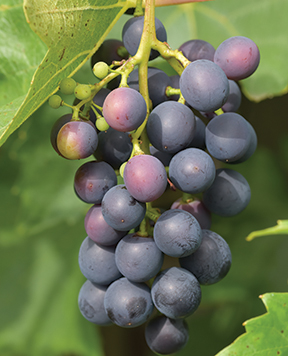
Uneven ripening may also occur. There is little the grower can do to prevent this from happening. Visible signs are where some berries in the clusters are very dark (and therefore ripe), while other berries in the same cluster are a lighter shade of color or even green or underdeveloped (underripe). The underripe berries will impart a harshness to the finished wine. The resulting must will also be lower in sugar and higher in acidity than you may have expected. Uneven ripening is common with all harvests and a minimal amount does not necessarily require intervention. You could consider sorting out these clusters. Excessive ripening issues may need more extensive intervention where, in addition to sorting, Brix and acid remediation actions will be needed. (More on how to handle a lower-than-expected Brix or a higher-than-expected acid level later.)
With the exception of bunch rot, quality issues might be somewhat mitigated by changing your wine style and making a rosé out of your red grapes. Minimizing skin contact and eliminating fermentation on the skins will limit contact with damaged areas and reduce off flavors and bacterial impacts to the wine.
The take-home message here is don’t pass damaged fruit into the winemaking process. If you are trying to “make your numbers” for wine volume, consider seeing if more of that varietal is available from that grower or another grower, or get a second varietal that can be processed and used later as a blend. Including bad grapes should never be the solution to meet an expected volume.
Not the Varietal You Expected
You arrive at the vineyard to pick up the grapes you ordered, but instead of that variety being available the grower has something else picked. This is not a common condition, but it does happen despite previous arrangements with the grower to purchase a specific variety (let’s face it, home winemakers purchasing small quantities will be at the bottom of the pecking order when it comes to supply). Previous planning efforts can come into play if you’ve identified a second source for your grapes as a potential backup. If you wind up with a different variety than what you planned for, make sure you have a yeast on hand that will provide you the expected fermentation and sensory qualities for the new variety. Keeping some more universal types of yeast in supply is never a bad idea.
Not the Volume You Expected
Although you ordered a specific amount of grapes, sometimes the grower may have to change allocations and can only give you a reduced volume. Final harvest volumes can have some level of unpredictability. Check to see if the grower has a different variety they can substitute for you so you can meet your desired numbers. Your planning efforts to identify a second source of grapes will also help. If you have grouped grape purchases with other winemakers in your area a larger order with the grower will improve odds of order fulfillment.
Not the Brix You Expected
With uneven ripening, your grapes will likely be at a lower sugar level than what you expected. To make the best wine possible out of this situation you might decide at this point to increase sugar levels artificially, which is certainly an option. However, it isn’t the only option. Consider these alternatives: Blend with another wine of higher Brix or do a dry rosé. A rosé wine will not have the skin and unripe seed contact through fermentation that would otherwise create a harsh and astringent red wine. With a rosé you will get all of the aromatics of the varietal and a nice crisp wine for summer consumption.
If you find that your grapes are of good quality but not at the level of ripeness desired for your finished wine, perhaps you just do nothing. A small delta between harvest expectation of Brix and delivered grapes does not necessitate cause for action. Accept that you will have a lighter style wine this vintage. A large delta between expected vs. delivered Brix might have consequences that require remediation.
For high Brix, make sure you understand the capabilities of the yeast you plan to use for fermentation. If you have a yeast that “tops out” at 15% alcohol and your must has a Brix level that will produce a 16% ABV wine, you may get a stuck fermentation and have to remediate that. From your planning efforts you can opt to have a yeast on hand that has a higher alcohol capability, or prior to fermentation add water at the appropriate volume to your must to reduce the overall sugar percentage.
Not the Acid You Expected
A serious grower will know the characteristics of the varieties they have planted and the farming practices that produce the best fruit and therefore the best wine. Some commercial growers work with the vintner to provide grapes that meet the parameters designated for that winery. Some growers and winemakers just rely on Brix to determine harvest date. Others will also consider pH levels and color of the seeds as an indicator for harvest. If you are deciding on a particular variety to produce for this vintage, understand its general characteristics in terms of acidity, and whether it is a low- or high-acid varietal.
Although each variety has its own typical acid characteristics, winemakers will still want to know the specific pH/titratable acidity (TA) levels before the winemaking process starts. This is because the growing conditions during the year and when harvest occurs ultimately influence the pH/TA levels at the time of harvest. Always be prepared to adjust acid levels at the point when the winemaking process starts, before the start
of fermentation.
Be sure to have plenty of tartaric acid on hand to make adjustments for a low acid wine at the crush pad. Anything more than a 1.0 g/L addition should definitely occur prior to fermentation, which will allow the increased acidity to “blend” into the wine more gracefully. Another on the fly decision may be to make a dry rosé, which benefits from the higher acid condition as long as the acid level is in the appropriate range for a white/rosé wine.
There are several other acid remediation options, but these are in later stages of winemaking. Refer to the article “Mastering Wine Acid Balance” from the February-March 2016 issue of WineMaker for more comprehensive details (available online for digital members at: https://winemakermag.com/technique/mastering-wine-acid-balance).
Smoke Taint Concerns
With the seemingly ever-present threat of wildfires across the globe, impacts to grape growing and wine production are occurring more often. Every vintage seems to be at risk in certain geographic areas and cause for concern is justified. The science behind smoke taint on wine is still evolving within the scientific community, with the Australian Wine Institute and UC-Davis in California being at the forefront of research. The information provided in this article comes from these researchers in relation, as we know it today, to how it occurs and how to correct or minimize the impact to wine production and quality.
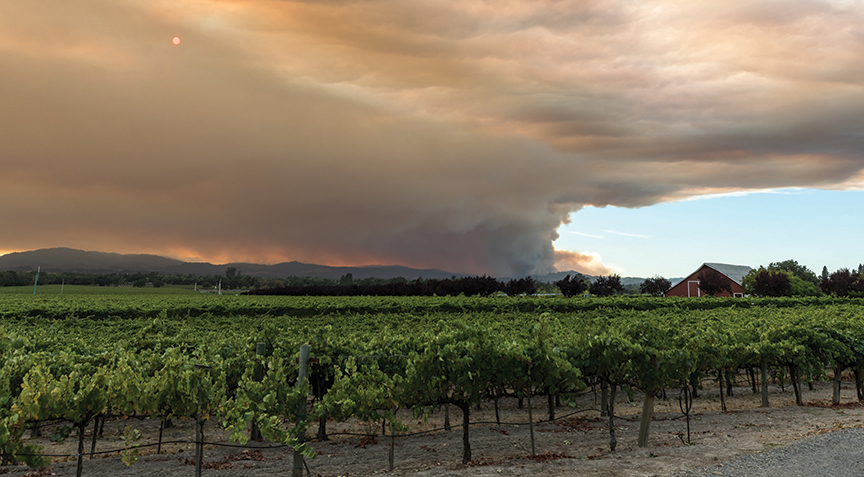
Sensory evaluations describe smoke taint as a distinctive lingering retro-nasal ashtray character. Addressing smoke taint in a wine after fermentation is expensive and only wineries with lots of resources and money can justify the work necessary to remove the smoke components from a finished wine. Research has determined a few things, however, that can be considered at the home winemaking level if you think your grapes might have been exposed.
Smoke taint takes place on the skin of the grapes in which volatile phenols react with grape sugars. If you minimize skin contact with the wine juice then the smoke components are less likely to transfer into the juice and finished wine.
The fresher the smoke (less than 24 hours) the greater the risk of smoke tainting the finished wine. On the other hand, the density of the smoke does not necessarily equate to increased smoke taint risk.
Smoke in your source vineyard is not necessarily cause for concern. Heavy smoke blown into the vineyard from a wildfire that is 50 miles away and took more than a day to blow in is not likely to affect the grapes and wine quality. Even if smoke persists in the vineyard for several days there is minimal impact. However, a wildfire that is very near the vineyard where smoke and ash is coming directly from the fire will likely have a significant impact on wine quality.
Although the timing of wildfires more often occur in the later stages of grape ripening, smoke taint can take place when grapes are pea sized and impacts may increase after veraison.
Rinsing off the grapes with water does not eliminate the smoke taint and only waters down the juice. However, if grapes have visible ash on their surface the recommendation is to wash off the ash at the winery before the winemaking process starts.
So what can the home winemaker do? The best choice according to the research community is to make a rosé wine. Rosé wine production minimizes or completely eliminates skin contact. If you suspect the worst case exposure it might be best to completely eliminate skin contact and make a vin gris-style rosé. The same considerations apply to white wines as well. Sensory evaluations by researchers note that there still may be sub-threshold impacts to wine quality.
Rosé to the Rescue
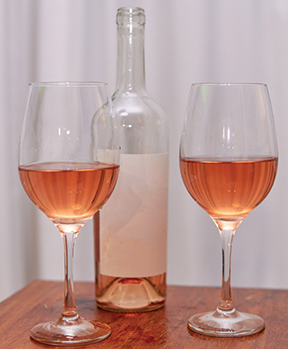
It should be obvious by now that making a rosé wine is an option that can be made on the fly at the crush pad to address many factors that might otherwise result in an inferior red wine. This article will not go into further detail on the making of Rosé wines, as the April-May 2022 issue had a cover story on the subject with extensive information (digital members can read it at: https://winemakermag.com/article/la-vie-en-dry-rose). If you plan to have this option in your back pocket, make sure you have the yeast, additives, and fermentation vessels on hand. Your rosé will benefit from a yeast selection that will bring out the aromatics of the variety. For the last several vintages we include plans to make a rosé out of two of the varieties in our vineyard, adjusting the volume of production based on grape quality and conditions in the vineyard.
At the end of the day, you can’t completely control what you receive at the crush pad and need to be ready to adjust your plans when grapes throw you a curve. As the saying goes, when offered lemons, make lemonade.



